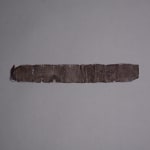Lead Scroll Inscribed with Mandaic Aramaic Text, 3rd Century CE - 5th Century CE
Lead
33 x 5.1 cm
13 x 2 in
13 x 2 in
X.0506
Further images
Aramaic is an ancient Semitic language that belongs to the Northwest line of Semitic languages. Known as early as the 9th Century B.C., Aramaic began as the language of the...
Aramaic is an ancient Semitic language that belongs to the Northwest line of Semitic languages. Known as early as the 9th Century B.C., Aramaic began as the language of the Aramaeans. Later, the language was adopted by many non-Aramaean peoples, including the Jew after the Babylonian exile. Eventually, Aramiac was used extensively throughout the Ancient Near East as the common tongue of merchants and governments. Although Aramaic and Hebrew are similar in vocabulary and pronunciation, there are enough differences to make the two languages distinct. Many important books of the Old and New Testament were composed in Aramaic, and the language is popularly believed to be the native tongue of Jesus. From the late 5th Century A.D. onwards, Aramaic supplanted Hebrew as the daily language of the Jews. For instance, the Gemara, the second division of the Talmud, was written entirely in Aramaic.
Mandaic is a specific dialect of the Eastern branch of Aramaic utilized in antiquity by the Mandaeans. The Mandaeans are an ancient religious sect that still exists today in limited numbers, concentrated along the border that divides modern Iraq and Iran. Although their religion features many elements of Judaism, Christianity, and Zoroastrianism, it is a distinct faith. The Mandaeans believe they are descended directly from Adam, who received the religious instructions of the faith directly from god. The modern Mandaean alphabet consists of twenty-four letters, although it starts and ends with the same character, reflecting their belief that all things in life return to their origin. This lead scroll has been carefully incised with a text written in the Classical Mandaic dialect of Aramaic. Discovered in Jerusalem, this scroll, which has been inscribed on both sides, might have originally belonged to a merchant who came from the East. Perhaps it is an official decree that was sent from the rulers of the Mandaeans to their counterparts in Ancient Israel. Considering that the origins of the Mandaeans are unknown, the mysteries of this Mandaic scroll are quite fitting.
Mandaic is a specific dialect of the Eastern branch of Aramaic utilized in antiquity by the Mandaeans. The Mandaeans are an ancient religious sect that still exists today in limited numbers, concentrated along the border that divides modern Iraq and Iran. Although their religion features many elements of Judaism, Christianity, and Zoroastrianism, it is a distinct faith. The Mandaeans believe they are descended directly from Adam, who received the religious instructions of the faith directly from god. The modern Mandaean alphabet consists of twenty-four letters, although it starts and ends with the same character, reflecting their belief that all things in life return to their origin. This lead scroll has been carefully incised with a text written in the Classical Mandaic dialect of Aramaic. Discovered in Jerusalem, this scroll, which has been inscribed on both sides, might have originally belonged to a merchant who came from the East. Perhaps it is an official decree that was sent from the rulers of the Mandaeans to their counterparts in Ancient Israel. Considering that the origins of the Mandaeans are unknown, the mysteries of this Mandaic scroll are quite fitting.









